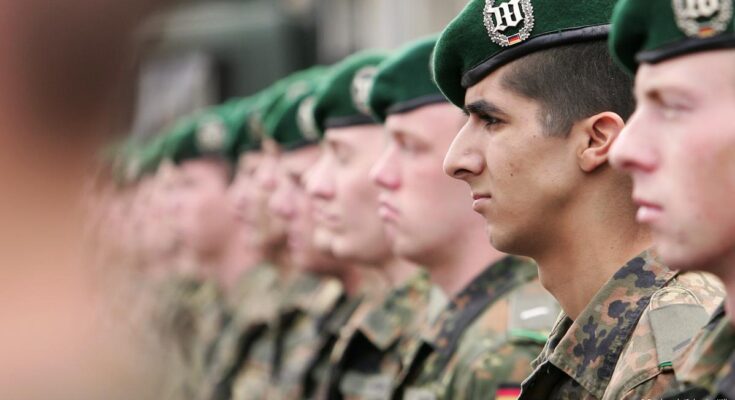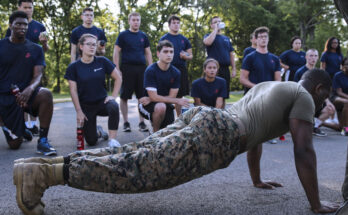Imperial German Army Recruitment: The Imperial German Army, a formidable force in Europe from 1871 to 1919, played a pivotal role in shaping world history.
Understanding this illustrious institution begins with delving into its origins and evolution. Founded after the unification of Germany under Prussian leadership, the Army was not just a military force but also a symbol of national pride and technological innovation.
Overview of Recruitment Practices in the Imperial German Army
The recruitment process in the Imperial German Army was a structured and systematic endeavor, designed to build an army that was both disciplined and robust. Prospective soldiers were selected through a detailed procedure that ensured only the most suitable candidates were enlisted. This process was a cornerstone in maintaining the high standards and operational excellence of the army.
Criteria for Enlistment
- Age: Enlistment age was a primary consideration, with the army targeting young men in their prime physical years.
- Health: Robust health was non-negotiable, ensuring that recruits could withstand the rigors of military life and combat.
- Social Status: The army also considered social background, looking for recruits who could adapt to the disciplined military environment.
- Other Factors: Additional criteria such as education, physical fitness, and even moral character played a role in the selection process.
Training and Preparation for New Recruits
Once enlisted, recruits underwent a comprehensive training regime that was both physically demanding and mentally challenging. This training was designed to prepare them for the realities of warfare and instill in them the discipline and skills necessary for success on the battlefield. The training covered various aspects, including physical conditioning, weapon handling, tactical maneuvers, and the ethos of the Imperial German Army. This rigorous preparation ensured that the recruits were battle-ready and capable of upholding the army’s standards in combat situations.
Understanding these recruitment and training practices provides a window into the operational mechanics of the Imperial German Army, a force that left a significant mark in military history.
Recruitment Programs of the Imperial German Army
This article delves into the various recruitment programs, special units, and incentives that characterized this formidable military force.
1. Varied Recruitment Programs
The recruitment in the Imperial German Army was a blend of voluntary enlistment and conscription. Conscription was a cornerstone, with every male citizen mandated to serve for a specific period, typically from the age of 17. However, voluntary enlistment was also encouraged, appealing to those with a strong sense of patriotism or seeking a professional military career.
2. Special Units and Divisions
The Army boasted numerous special units and divisions, each with a unique role and prestige. These included elite guards, cavalry units, and specialized infantry divisions. The existence of such diverse units provided opportunities for recruits with different skills and interests, enhancing the army’s versatility and effectiveness.
3. Benefits and Incentives for Recruits
To attract and retain soldiers, the Imperial German Army offered various benefits and incentives. These included monetary bonuses, promises of career advancement, and, in some cases, land grants upon completion of service. Such incentives not only boosted recruitment numbers but also helped maintain a high level of morale and loyalty among the troops.
However, the recruitment programs of the Imperial German Army were multifaceted and dynamic, contributing significantly to its strength and capabilities. The blend of conscription and voluntary enlistment, the existence of specialized units, and the attractive incentives collectively forged an army that was both formidable and highly respected in its time.
Application Process for the Imperial German Army: A Comprehensive Guide
Joining the Imperial German Army is a journey that begins with understanding and following a structured application process. This guide provides a step-by-step overview, detailing the required documents, prerequisites, and insights into the timeline and selection process.
Step-by-Step Guide on How to Apply
- Initial Research: Start by gathering information about the Imperial German Army. Understanding its history, structure, and the roles available will help you make an informed decision.
- Eligibility Check: Ensure you meet the basic requirements, such as age, nationality, and physical fitness standards. These criteria are crucial for proceeding with your application.
- Document Preparation: Collect necessary documents. This typically includes identification papers, educational certificates, and any relevant military or work experience records.
- Application Submission: Fill out the application form with accuracy. Double-check all entries for correctness before submission.
- Contact and Communication: Provide valid contact information and check your email regularly for updates regarding your application status.
Required Documents and Prerequisites
- Identification Proof: A valid ID card or passport.
- Educational Certificates: High school diploma or higher education documents.
- Physical Fitness Certificate: From a certified medical practitioner.
- Background Check: Proof of a clean legal record.
Prerequisites include a minimum age requirement (usually 18 years), a specific physical condition, and sometimes, a certain level of education or skill set depending on the role applied for.
Timeline and Selection Process
- Application Review: This process can take several weeks. The army reviews your documents and eligibility.
- Interview and Assessment: If your application is shortlisted, you will be invited for interviews and physical assessments.
- Training Period Notification: Successful candidates will receive information about the training period and induction details.
- Final Selection: After the completion of training, candidates are formally inducted into the Imperial German Army based on their performance and suitability.
Note: The process may vary slightly depending on the specific requirements of the Imperial German Army at the time of application.
Life in the Imperial German Army: Daily Routines, Training, and Career Advancement
Daily Life and Duties of a Soldier in the Imperial German Army
The daily life of a soldier in the Imperial German Army, an institution marked by strict discipline and a strong sense of duty, was both challenging and structured. Soldiers typically began their day early with reveille, followed by rigorous physical exercises to maintain peak fitness levels. Their daily routine included duties like weapon maintenance, drills, and guard duties. Soldiers also engaged in various chores around the barracks or camp, fostering a sense of camaraderie and teamwork. The importance of discipline was paramount, with strict adherence to military protocols and hierarchy.
Training Regimen and Military Discipline
Training in the Imperial German Army was intensive and comprehensive, designed to prepare soldiers for the rigors of military life and the demands of warfare. Recruits underwent basic training that included physical fitness, marksmanship, tactical maneuvers, and the handling of various military equipment. Advanced training often focused on specialized skills, depending on the soldier’s assigned role. Discipline was a cornerstone of this training, with a strong emphasis on obedience, punctuality, and respect for the chain of command. This strict discipline was not only a means of maintaining order but also a way to instill a sense of pride and excellence in the soldiers.
Opportunities for Advancement and Career Paths
The Imperial German Army offered various opportunities for career advancement, especially for those who demonstrated exceptional skill, leadership, and dedication. Soldiers could rise through the ranks, from enlisted ranks to non-commissioned officers (NCOs), and potentially to commissioned officers. Specialized training programs were available for soldiers interested in specific fields such as engineering, artillery, or the cavalry. Additionally, exemplary service could lead to medals and recognition, further enhancing a soldier’s career prospects. The army was not just a place of duty; it was an institution where one could build a rewarding and respected career.
Apply Now
FAQs about the Imperial German Army and Its Recruitment
What Was the Imperial German Army?
The Imperial German Army was the ground force of the German Empire, operating from 1871 to 1919. It played a pivotal role in European military history, particularly during World War I.
How Were Soldiers Recruited in the Imperial German Army?
Recruitment in the Imperial German Army was primarily based on conscription. All men aged 17 to 45 were liable for military service, with 20 being the age for active duty enlistment.
Did the Imperial German Army Accept Volunteers?
Yes, the Imperial German Army did accept volunteers. Young men who wanted to join earlier than the required age could volunteer, provided they met certain conditions like physical fitness and basic education.
What Was the Training Like in the Imperial German Army?
Training in the Imperial German Army was rigorous and emphasized discipline, physical fitness, and proficiency in weapon handling. Soldiers underwent basic training followed by specialized training depending on their assigned roles.
Were There Any Non-German Soldiers in the Imperial German Army?
The Imperial German Army was predominantly composed of German nationals. However, it also included personnel from various German states and, in some cases, foreign volunteers and enlisted men from allied or occupied nations.
How Long Was the Service Period in the Imperial German Army?
The standard service period for conscripted soldiers in the Imperial German Army was two to three years for active service, followed by several years in the reserves.
Did the Imperial German Army Participate in Overseas Conflicts?
While the primary focus of the Imperial German Army was European conflicts, it did engage in overseas actions, particularly in the German colonies, during its existence.
What Were the Ranks in the Imperial German Army?
The Imperial German Army had a structured rank system, ranging from enlisted men (like Private and Sergeant) to higher ranks (like Lieutenant, Captain, and General).
How Did the Role of the Imperial German Army Change Over Time?
Initially focused on defending the German Empire and its interests, the role of the Imperial German Army evolved, especially during World War I, to include offensive operations on multiple fronts across Europe.
Did the Imperial German Army Use Specialized Units?
Yes, the Imperial German Army had various specialized units, including cavalry, artillery, engineers, and later in its existence, early forms of armored and aviation units.
Conclusion:
Understanding the historical context of military recruitment, particularly in the case of the Imperial German Army, is crucial. It helps us comprehend the underpinnings of military power and its impact on society and governance. The recruitment strategies employed during this era were a blend of tradition, necessity, and innovation, revealing much about the German Empire’s aspirations and constraints.
For those intrigued by military history or societal structures, further reading and research into this topic can be incredibly rewarding. Delving deeper into the Imperial German Army’s recruitment practices opens a window into the past, offering insights into how historical military structures have shaped our current world. It’s an invitation to explore the complex interplay between military, society, and history.
In conclusion, the recruitment strategies of the Imperial German Army are more than just a historical footnote. They are a testament to the dynamic and often complex relationship between a nation’s military needs and its societal framework. Understanding this relationship is key to grasping the broader strokes of history and its ongoing influence on the present and future.



